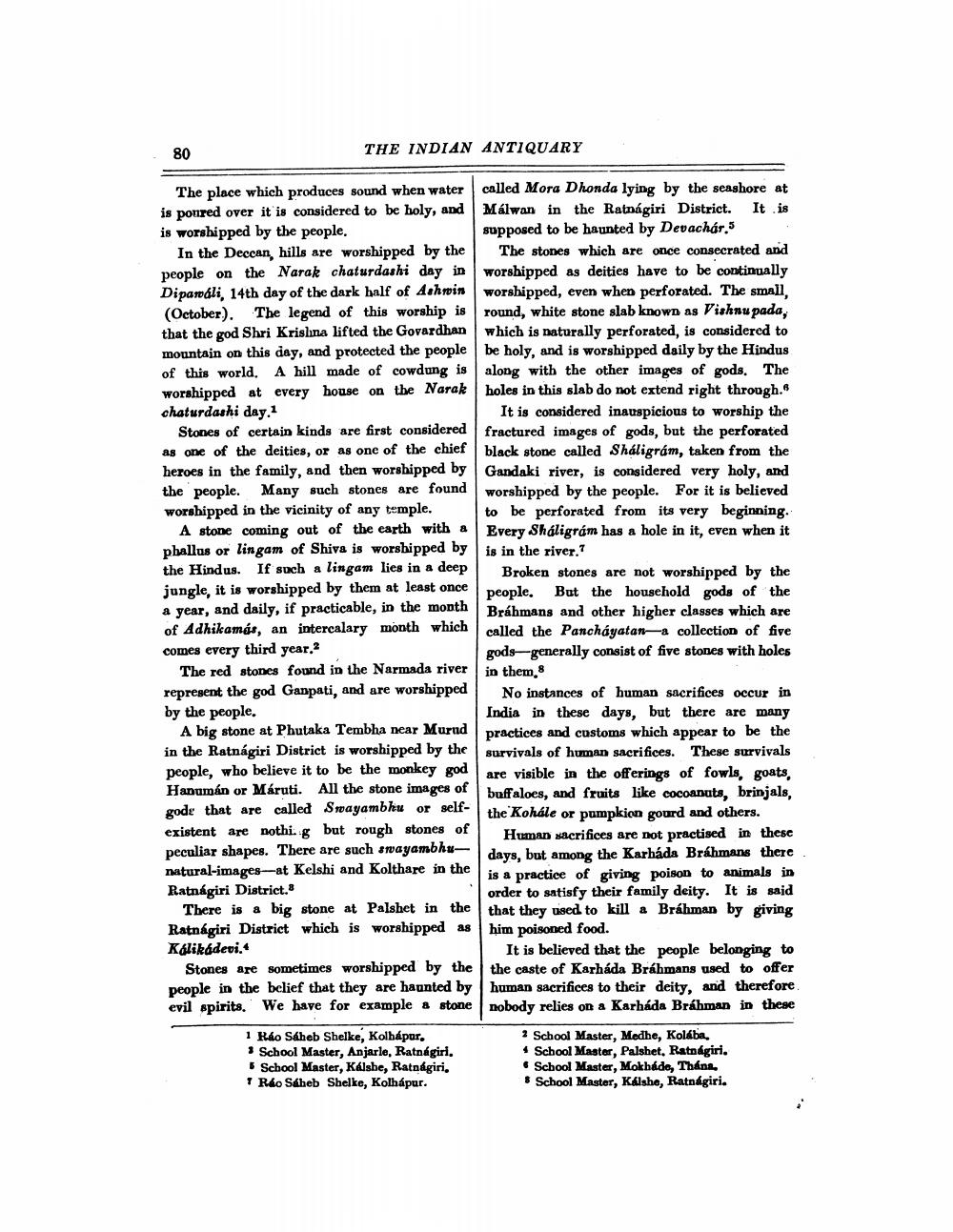________________
.
80
THE INDIAN ANTIQUARY
The place which produces sound when water called Mora Dhonda lying by the seashore at is poured over it is considered to be holy, and Málwan in the Ratnagiri District. It is is worshipped by the people.
supposed to be haunted by Devachár.5 In the Deccan, hills are worshipped by the The stones which are once consecrated and people on the Narak chaturdashi day in worshipped as deities have to be continually Dipawoli. 14th day of the dark half of Ashwin worshipped, even when perforated. The small.
(October). The legend of this worship is round, white stone slab known as Vishnu pada, that the god Shri Krislina lifted the Govardhan which is naturally perforated, is considered to mountain on this day, and protected the people be holy, and is worshipped daily by the Hindus of this world. A hill made of cowdung is along with the other images of gods. The worshipped at every house on the Narak holes in this slab do not extend right through. chaturdashi day.1
It is considered inauspicious to worship the Stones of certain kinds are first considered fractured images of gods, but the perforated as one of the deities, or as one of the chief black stone called Shaligrám, taken from the heroes in the family, and then worshipped by Gandaki river, is considered very holy, and the people. Many such stones are found worshipped by the people. For it is believed worshipped in the vicinity of any temple. to be perforated from its very beginning.
A stone coming out of the earth with a Every Sháligrám has a hole in it, even when it pballus or lingam of Shiva is worshipped by is in the river.7 the Hindus. If such a lingam lies in a deep
Broken stones are not worshipped by the jungle, it is worshipped by them at least once
people. But the household gods of the a year, and daily, if practicable, in the month
Bráhmans and other higher classes which are of Adhikamás, an intercalary month which
called the Panchayatan-a collection of five comes every third year.
gods-generally consist of five stones with holes The red stones found in the Narmada river in them.8 represent the god Ganpati, and are worshipped No instances of human sacrifices occur in by the people.
India in these days, but there are many A big stone at Phutaka Tembha near Murud
practices and customs which appear to be the in the Ratnagiri District is worshipped by the survivals of human sacrifices. These survivals people, who believe it to be the monkey god
are visible in the offerings of fowls, goats, Hanumán or Máruti. All the stone images of landfalse
buffaloes, and fruits like cocoanuts, brinjals, gode that are called Swayambhu or self
the Kohale or pumpkien gourd and others. existent are nothi. 8 but rough stones of
Human sacrifices are not practised in these peculiar shapes. There are such swayambhu- lde
days, but among the Karháda Brahmans there natural-images--at Kelshi and Kolthare in the
is a practice of giving poison to animals in Ratnagiri District.
order to satisfy their family deity. It is said There is a big stone at Palshet in the that they used to kill a Brahman by giving Ratnagiri District which is worshipped as him poisoned food. Kdlikádedi.
It is believed that the people belonging to Stones are sometimes worshipped by the the caste of Karháda Bráhmans used to offer people in the belief that they are haunted by human sacrifices to their deity, and therefore evil spirits. We have for example a stone nobody relies on a Karháda Bráhman in these
1 Ráo Saheb Shelke, Kolbápor, * School Master, Anjarle, Ratnagiri.
School Master, Kálshe, Ratnagiri, Ráo Sáheb Shelle, Kolháper.
2 School Master, Medhe, Kolába. - School Master, Palshet. Ratnagiri. . School Master, Mokháde, Tháns $ School Master, Kálshe, Ratnagiri.




